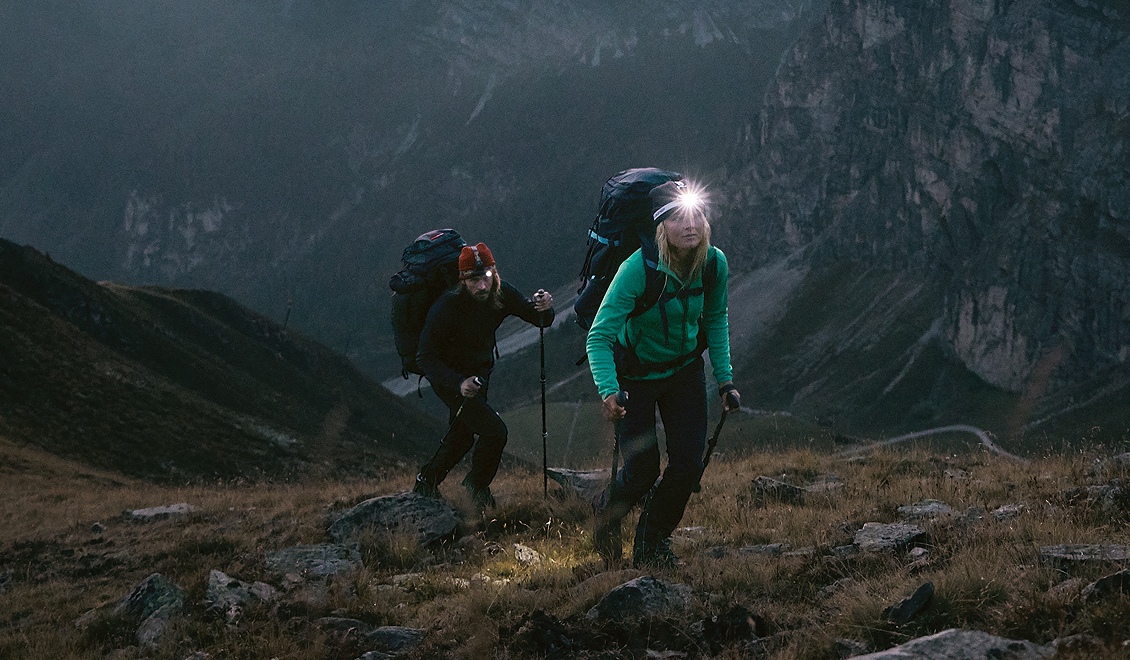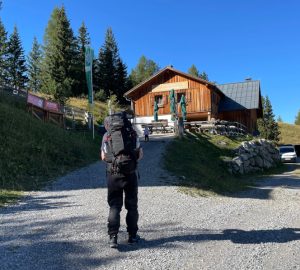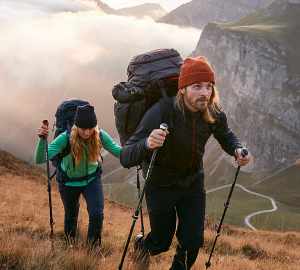Are you planning to cross the Alps on foot? Then you need some equipment for your hike. We explain what you should definitely take with you and what you can safely do without.
If you’re hiking across the Alps on foot, you’ll need a lot of equipment. The challenge: Everything you take with you, you have to carry yourself in your backpack across the Alps. With several hundred meters of altitude and long walking times every gram counts. Because a backpack that’s too heavy not only spoils your mood, but also puts a strain on your knees. At the same time, some things are indispensable. Last but not least, you should not save on safety.
The right backpack for your crossing of the Alps
A good backpack is probably one of the most important pieces of equipment for a crossing of the Alps. Besides the shoes, it can be decisive for whether your hike will be a pleasure or a drudgery.
Your backpack should be large enough to carry all the items you need, but also comfortable enough to wear for extended periods of time. Make sure it has a good carrying system that fits your anatomy. The load should not only rest on your shoulders, but should be transferred mainly to your hips. Here there are different models for women and men that fit the respective physique. The padding should also be good and at the same time allow sufficient ventilation. The lower the weight of your backpack, the better.
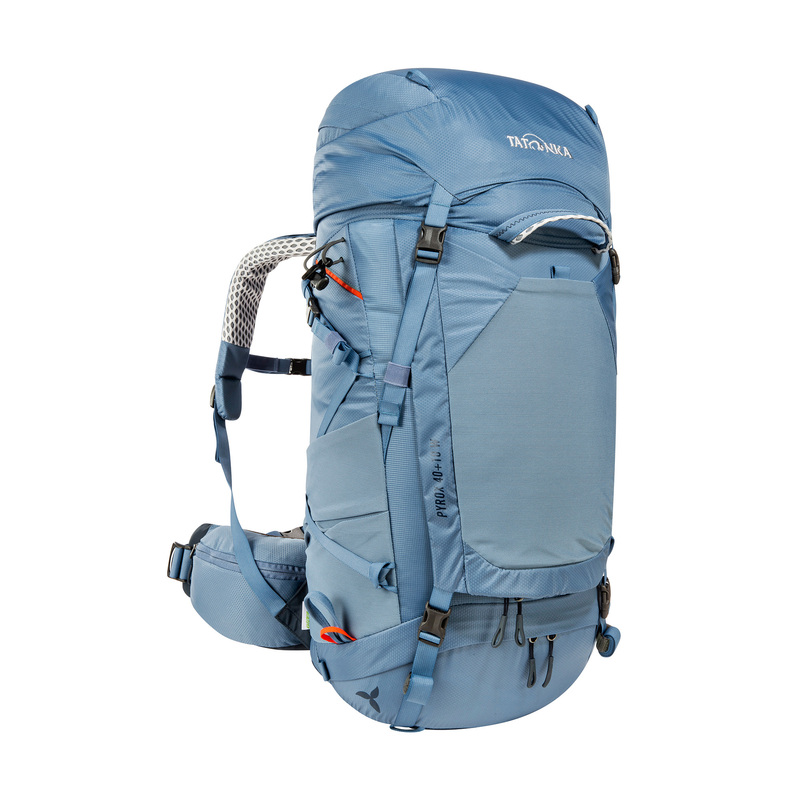
At Tatonka you will find the right backpack for your tour across the Alps. Whether unisex or special women’s model. With adjustable carrying systems that noticeably relieve your back on tour.
The following applies to the weight of your fully packed backpack: When hiking, it should not exceed 20 percent of your body weight, less is better. In terms of volume, a size between 35 and 50 liters has proven itself – depending on whether you also need crampons, rope or glacier equipment in addition to normal hiking equipment. So the choice of backpack also depends on the choice of route. For one of the most popular Alpine crossings, the approximately one-week tour from Oberstdorf to Merano, you should be able to handle a total weight of no more than 10 kilos.
In any case, you should pack your backpack completely in advance of the crossing of the Alps to see if there is enough room for everything. You should also do an extensive test hike with your fully packed backpack. This way you can see if it really fits you and is optimally adjusted.
The right hiking boots
A pair of high-quality, well-fitting hiking boots of the right category is crucial for the success of a crossing of the Alps. The shoes should be sturdy, waterproof and have a sole that provides optimal grip. It is important that the shoes are well broken in before crossing the Alps to avoid blisters and pain.
Reading tip: How to treat and avoid blisters
Hiking boots are divided by many manufacturers into categories, which are labeled with letters from A to D. For an alpine crossing – depending on the route – shoes of category B or B/C are suitable. The following features are important:
- a clearly raised cap at the front of the toe and at the back of the heel
- a torsionally stiff sole with a deep tread for safety and relief
- a stable, straight sole edge for safe tread on snow or mud
For most routes across the Alps, category B shoes should be sufficient as long as they fulfill these characteristics. However, if your route requires crampons, you’ll need at least category B/C shoes that are suitable for crampon use. Even firmer shoes (such as category C) offer even more sure-footedness. However, they also have a higher weight, which is a handicap for further routes with luggage. It is important to find the right balance between safety and comfort. Your specialist dealer can give you expert advice on this.
In any case, shoes that go over the ankle are recommended. They can provide a certain amount of protection against twisting and keep out stones and other things that could hurt your ankles.
Extensive break-in is a must for hiking boots – this is even more true before crossing the Alps.
During the tour, make sure that your shoes can dry overnight in case they get wet. Otherwise, friction and blisters can occur. There are also a few tricks when lacing your hiking boots that can make them much more comfortable to wear. Especially if there are still some daily stages ahead, small precautions on the footwear also count, which help to avoid difficulties up to a premature termination of the overall project.
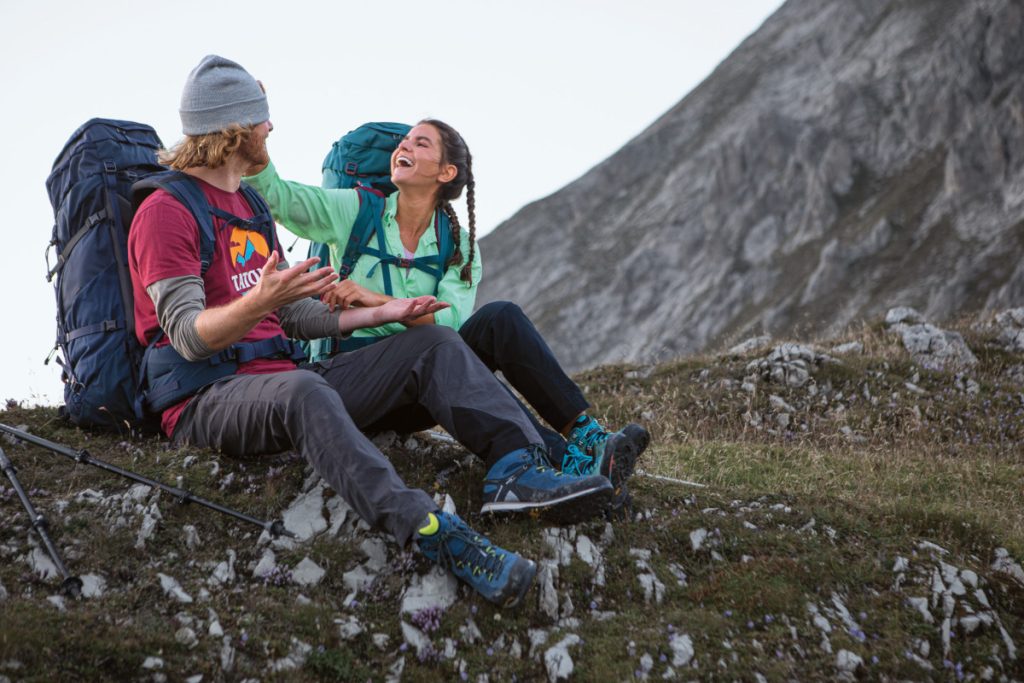
Clothing for your alpine crossing
- Underwear
Proven and popular here is functional underwear, especially made of merino wool. They wick away sweat quickly and keep you dry and warm at the same time. Functional shirts can also be worn as T-shirts. A functional shirt can also be washed on occasion, as it dries overnight – another option for saving weight. - Long Sleeve
As a second layer you can wear a long sleeve or a functional shirt. - Sweater or jacket
Softshell jackets or windproof fleece jackets are recommended as protection against wind and cold. Zip pants are particularly practical for hiking. A pair of long pants can quickly be turned into a pair of shorts – without adding weight to your backpack. - Rain and weather clothing
Thin jackets and pants made of a functional membrane that are waterproof and breathable at the same time are perfect for crossing the Alps. - Socks
Special hiking socks (made of merino wool) greatly increase the comfort of your hiking boots. They have no bulky seams and are reinforced in the important places. If you are prone to blisters, here are a few tips. - Spare clothes
Basically, you only need a reserve for the clothes that you wear directly on your skin. Merino wool generally starts to smell unpleasant later than synthetic fibers. - Gloves and hat
Thin gloves belong in every backpack. A headgear protects from the sun and in the rain, wind and cold.
Additional hiking equipment
- Trekking poles
Trekking or hiking poles are a great help when tackling steep ascents and descents. They take the strain off your knees and help with balance. Make sure the poles are lightweight, sturdy and have adjustable lengths. You can read about how to adjust them and what’s important when using them in our article on the subject. - Headlamp
You should always plan your daily stages in such a way that you reach your destination in time before nightfall. The lamp is therefore part of the emergency equipment. But it can also be handy at the hut, if you have to leave the dormitory at night.

Equipment for overnight stay
In most regions of the Alps, wild camping with tents is prohibited. So you will spend the night mainly in mountain huts, in the valley possibly also in inns etc.. Here you do not need any extra equipment. However, two things are important. Firstly, you need hut shoes, i.e. slippers, light casual shoes or similar, which you can wear at the hut or inn. Secondly, you should have a hut sleeping bag with you. On huts of the German Alpine Association (DAV) it is mandatory for hygienic reasons! The sleeping bag is not for warmth insulation, but for cleanliness. It prevents direct skin contact with the blanket and mattress. Therefore, a light version made of cotton, silk or microfiber is sufficient. For children, the warming version made of fleece may also be suitable. In any case, a normal sleeping bag is unsuitable: It is too heavy, too warm and takes up too much space in your backpack.
Tip: Don’t forget earplugs! After all, you should be well rested and fit for the next day even after a night in a dormitory or mattress camp.
First aid and health
First aid kit belongs in every backpack and should always be with you – especially in the mountains. For all those who want to read again, we have summarized in an article how you get help in the mountains and what is important for safety on the mountain.
In addition to the first aid kit, you should also pack blister plasters. In case of emergency, they will make it much easier for you to continue hiking.
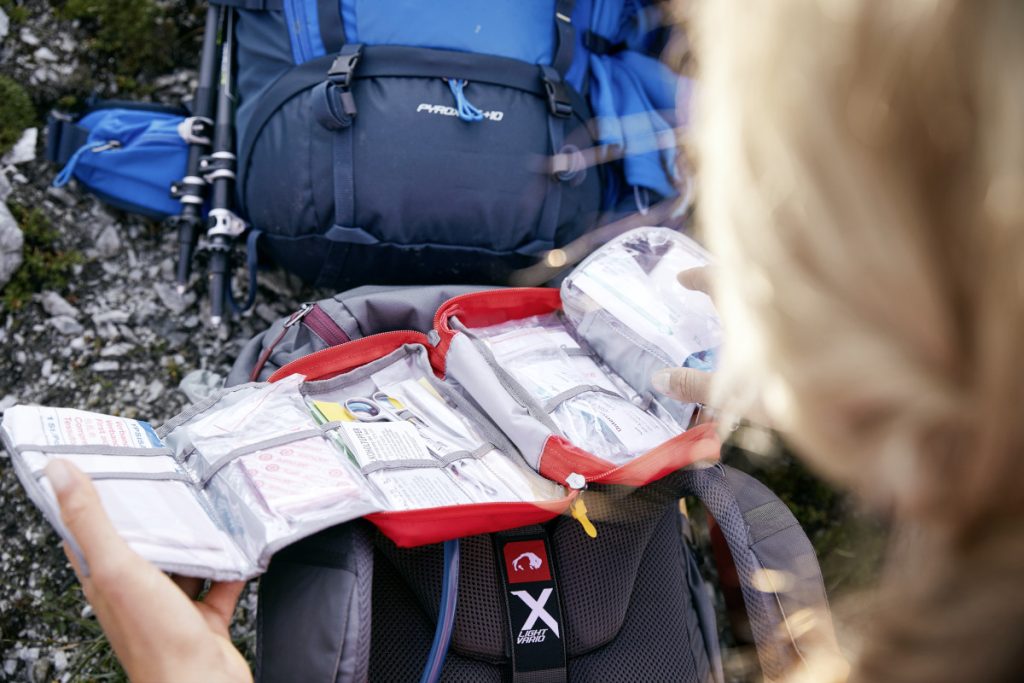
Cosmetics
To the slimmed down, but well-considered version of your wash bag you should in any case pack sunscreen and lip balm with sun protection factor. A microfiber towel saves space and serves its purpose on your alpine crossing. A small amount of detergent can also be a good idea to spontaneously wash out a piece of clothing. In an emergency, you can also use soap or shower gel.
Documents, identity papers, cash
You will also need a few documents when crossing the Alps. After all, you’ll be crossing several national borders, albeit within the EU. Here is what you need:
- Identity card
- Credit card and cash (especially for mountain huts)
- Insurance card
- Alpine club card ( if available)
- Watch with alarm clock function (or simply your cell phone)
- Waterproof storage bags or alternatively plastic bags (to keep your documents dry in heavy rain)
- Hiking guide and maps for route planning
Food and drink
If you stay in mountain huts during your alpine crossing, you will be well supplied with food for breakfast as well as in the evening. In most huts breakfast is included and after a hard day a warm meal in the hut is most certainly welcome. Also during the day on most routes are refreshment facilities available. You should pay attention to this when planning your tour and prepare accordingly if this is not the case.
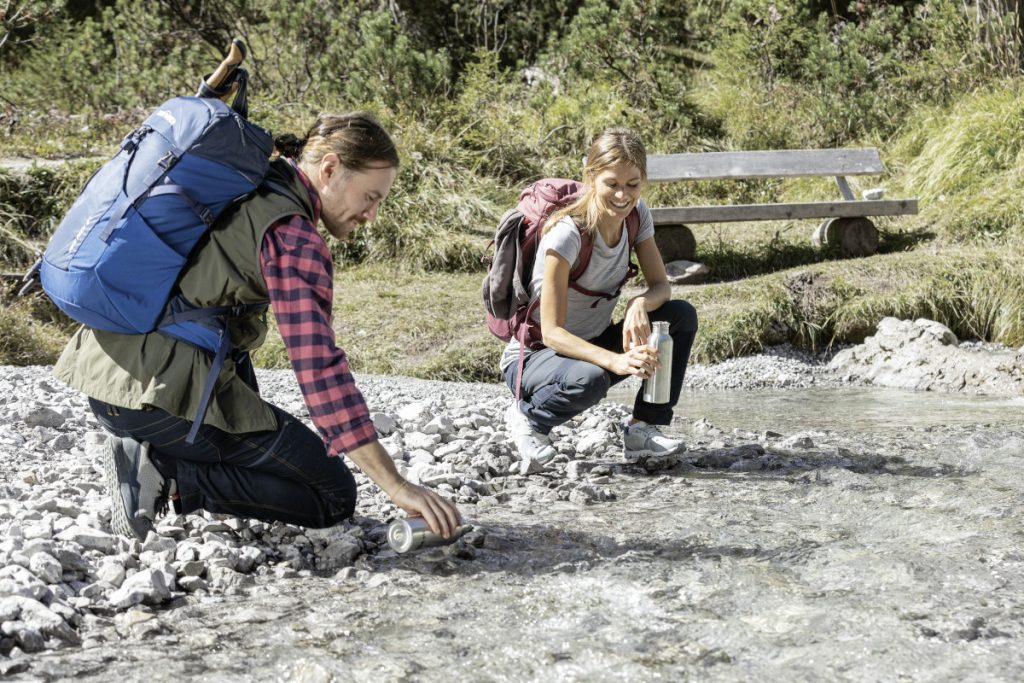
However, you need to drink enough in any case! In addition to a (thermal) water bottle, a hydration bladder is ideal for multi-day hikes to save weight. Make sure you always have enough liquid with you.
Reading tip: 10 golden mountain hut rules for a relaxed stay.
Having quick energy on hand for in-between is also not to be underestimated. If you’re in a slump, a small snack can often give you strength and a sense of purpose. Nuts, dried fruit, muesli bars, but also chocolate bars are always a good idea.
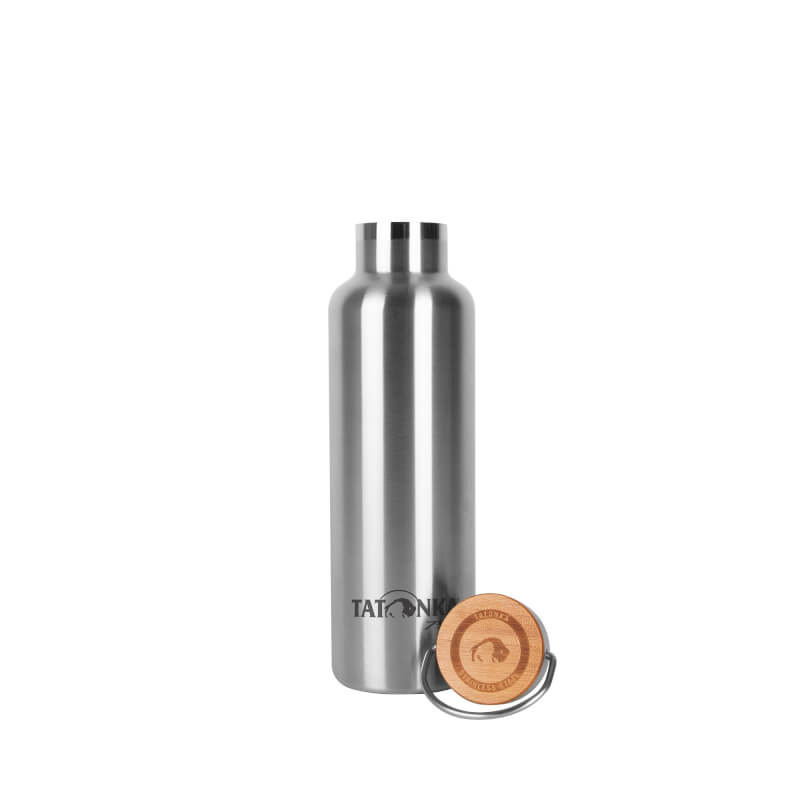
In our range we offer you drinking bottles in different sizes and designs. With narrow or wide opening or as an insulated variant for cold and hot drinks. All made of high quality and sustainable stainless steel.
Conclusion: Test your equipment before crossing the Alps!
For an alpine crossing comes a lot of equipment together. It is best to start planning in good time. Then you have enough time to try everything out and replace or supplement it if necessary. A test hike in full gear (preferably several days with an overnight stay) is always a good idea before a crossing of the Alps. This will allow you to familiarize yourself with your equipment; you will notice what you are missing and what you will unpack unused after the hike. This way you can assess whether you can handle the weight of your backpack and can consider whether optional items such as camera, reading material, etc. should really be taken across the Alps. Prepared like this, nothing should stand in the way of the adventure of crossing the Alps!
Tip: Here you can find more articles of our series about crossing the Alps on foot:




